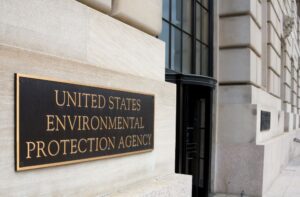Last month, the EPA announced a final rule designating two polyfluoroalkyl substances (PFAS) chemicals as hazardous substances under the Comprehensive Environmental Response, Compensation, and Liability Act (CERCLA):
- Perfluorooctanoic acid (PFOA)
- Perfluorooctanesulfonic acid (PFOS)
PFAS are a group of manufactured chemicals that are also referred to as “forever chemicals” because of their resistance to breaking down in the environment over time. They’ve been produced by a variety of industries since 1940 for use in many consumer products, such as paint, nonstick Teflon, cleaning and personal care products, and food packaging materials. PFAS are known for their water- and stain-repellant materials and have been used in fast-acting firefighting products.
PFAS contamination in people can occur through consumption of contaminated food or water and through skin absorption and has been linked to a host of health issues, including cancer, immune system deficiencies, liver damage, negative developmental effects in infants and children, lower fertility rates, and increased cholesterol.
“This final action will address PFOA and PFOS contamination by enabling investigation and cleanup of these harmful chemicals and ensuring that leaks, spills, and other releases are reported,” an EPA news release says. “This action builds on the recently finalized standards to protect people and communities from PFAS contamination in drinking water and represents the latest step the Biden-Harris Administration is taking to protect public health and welfare and the environment under EPA’s PFAS Strategic Roadmap and to prevent cancer before it starts through the Biden Cancer Moonshot.”
“President Biden understands the threat that ‘forever chemicals’ pose to the health of families across the country. That’s why EPA launched its PFAS Strategic Roadmap, a whole-of-agency approach to protecting public health and addressing the harm to communities overburdened by PFAS pollution,” EPA Administrator Michael S. Regan said in the Agency news release. “Designating these chemicals under our Superfund authority will allow EPA to address more contaminated sites, take earlier action, and expedite cleanups, all while ensuring polluters pay for the costs to clean up pollution threatening the health of communities.”
What does CERCLA designation mean?
CERCLA, also known as “Superfund,” designation helps protect public health and the environment from potentially harmful exposure to CERCLA-designated chemicals and will provide tools to hold polluters accountable. Designation enables cost recovery and enforcement authorities to address PFOA and PFOS releases, which ensures the polluters, known as potentially responsible parties (PRP), pay for investigations and cleanup.
“PRPs may include current and former site owners and operators, as well as certain generators and transporters of hazardous substances,” law firm Jones Day says in a Lexology article. “Accordingly, under the final rule, agencies or other parties conducting CERCLA response actions to address PFOS and PFOA contamination will be permitted to seek to recover the costs of the response action from PRPs.”
This designation for these two types of PFAS is expected to improve transparency around releases of these harmful chemicals.
The rule requires entities to immediately report releases of PFOA and PFOS that meet or exceed the reportable quantity of 1 pound or more within a 24-hour period to the National Response Center, the state or tribal emergency response commission, and the local or tribal emergency planning committee (local emergency responders). Entities don’t need to report past releases of PFOA or PFOS following the requirements of CERCLA Section 103 and Section 111(g) or the Emergency Planning and Community Right-to-Know Act (EPCRA) Section 304 if they aren’t continuing as of the effective date of the rule.
“Additionally, the CERCLA hazardous substance designation triggers additional reporting requirements under [EPCRA],” the Jones Day article continues. “EPCRA mandates reporting requirements on the storage, usage, and release of CERCLA-designated hazardous substances, including follow-up written reporting within 30 days of a reportable release.”
Other provisions require federal entities that transfer or sell their property to report the storage, release, or disposal of PFOA or PFOS on the property and include a covenant (commitment in the deed) stating they’ve cleaned up any resulting contamination or will do so in the future, if necessary, as required under CERCLA 120(h). Section 306 of CERCLA requires the Department of Transportation to list and regulate these substances as hazardous materials under the Hazardous Materials Transportation Act.
CERCLA enforcement discretion policy
In addition to the final rule, the EPA is issuing a separate CERCLA enforcement discretion policy that makes clear the Agency will focus enforcement on parties that significantly contribute to the release of PFAS chemicals into the environment, including parties that have manufactured PFAS or used PFAS in the manufacturing process, federal facilities, and other industrial parties.
The policy states, “EPA does not intend to pursue otherwise potentially responsible parties where equitable factors do not support seeking response actions or costs under CERCLA, including, but not limited to, the following entities:
- Community water systems and publicly owned treatment works (POTW);
- Municipal separate storm sewer systems (MS4);
- Publicly owned/operated municipal solid waste landfills;
- Publicly owned airports and local fire departments; and
- Farms where biosolids are applied to the land.”
The final rule will be effective July 8, 2024.

